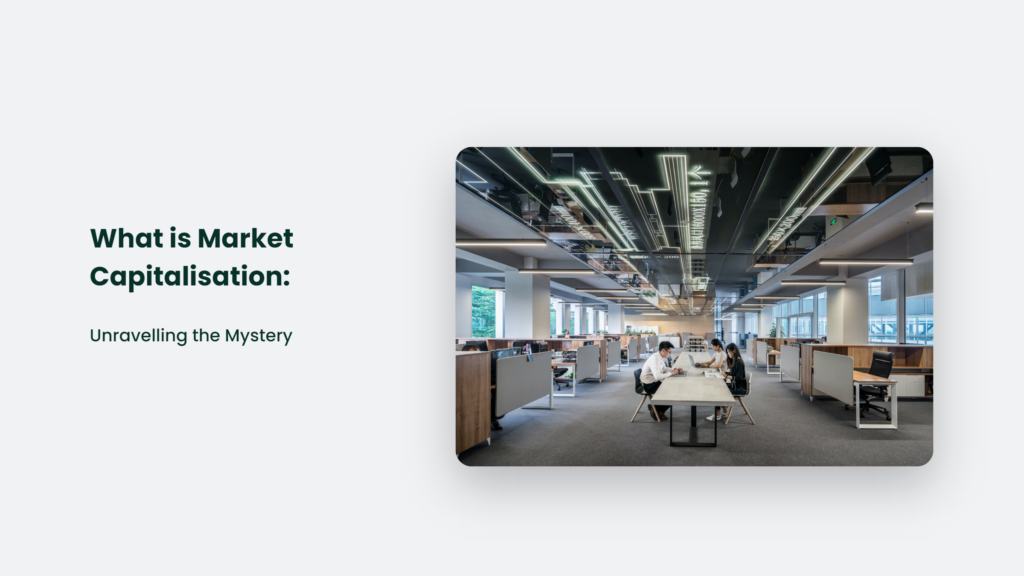Welcome, dear reader, to the astonishing world of market capitalisation! You might be wondering, “What is market capitalisation?” Fear not, for we shall embark on a thrilling journey to unravel the mystery of this financial phenomenon. Along the way, we’ll encounter anecdotes, opinions, and insights that will make this seemingly mundane topic a rollercoaster ride of emotions and enlightenment.

What is Market Capitalisation: The Colossal Beast
Market capitalisation, or “market cap” for short, is the total value of all outstanding shares of a publicly traded company’s stock. It’s a colossal beast, a titan of the financial world, and it’s calculated by multiplying the company’s stock price by the number of outstanding shares. But why should you care about this gargantuan figure? It’s a powerful indicator of a company’s size, financial stability, and growth potential.
Imagine two companies, one with a market cap of $10 billion and another with a market cap of $100 billion. Which one would you consider more stable and reliable? The answer is obvious: the one with the larger market cap. It’s like comparing a tiny ant to a mighty elephant – the difference in size and strength is staggering.
The Three Titans: Large, Mid, and Small Cap Stocks
Market capitalisation can be divided into three categories, each with its own unique characteristics and potential for growth. Behold, the three titans of market cap:
Large Cap Stocks:
These are the behemoths of the financial world, with market caps typically exceeding $10 billion. They’re often well-established, financially stable companies that have proven their worth over time. Think Apple, Amazon, and Google – the titans that dominate the market landscape.
Mid-Cap Stocks:
These are the middleweights, with market caps ranging from $2 billion to $10 billion. They’re often growing companies with the potential to become large-cap stocks in the future. They may not be as well-known as their larger counterparts, but they can still pack a punch in terms of growth potential.
Small Cap Stocks:
These are the underdogs, with market caps below $2 billion. They’re often young, innovative companies with the potential for explosive growth. However, they also come with a higher degree of risk, as they may not have the financial stability or proven track record of their larger counterparts.
The Market Cap Dance: A Tale of Two Stocks
Let’s take a closer look at how market capitalisation can change over time, using two hypothetical companies as examples: Company A and Company B.
Company A starts with a stock price of $10 and 1 million outstanding shares, giving it a market cap of $10 million. Company B, on the other hand, has a stock price of $20 and 500,000 outstanding shares, resulting in a market cap of $10 million as well. At this point, both companies have the same market cap, but their stock prices and number of outstanding shares are different.
Now, imagine that Company A’s stock price doubles to $20 while Company B’s stock price remains the same. Company A’s market cap would soar to $20 million, while Company B’s would remain at $10 million. In this scenario, Company A has become a more valuable company in the eyes of the market despite starting with the same market cap as Company B.
The Power of Market Capitalisation: A Force to Be Reckoned With
Market capitalisation is a force to be reckoned with in the financial world. It can influence investor decisions, affect stock prices, and even determine a company’s inclusion in major stock indices. Here are some ways in which the power of market cap can manifest itself:
- Investor Decisions: Market cap can help investors determine the level of risk they’re willing to take on. Large-cap stocks are generally considered safer investments, while small-cap stocks may offer higher growth potential but come with greater risk.
- Stock Prices: A company’s market cap can influence its stock price, as investors may be more willing to pay a premium for shares of a company with a larger market cap.
- Index Inclusion: Major stock indices, such as the S&P 500 and the Dow Jones Industrial Average, use market capitalisation as a criterion for inclusion. Companies with larger market caps are more likely to be included in these indices, which can lead to increased visibility and investment.
The Market Cap Conundrum: A Riddle Wrapped in a Mystery
As powerful and influential as market capitalisation may be, it has flaws and limitations. For one, it’s a snapshot in time, and stock prices can be volatile, causing market caps to fluctuate wildly. Additionally, market cap doesn’t account for a company’s debt or other financial factors that may impact its overall value.
So, is market capitalisation the be-all and end-all of a company’s worth? The answer is a resounding “no.” While it’s an important metric to consider, it’s just one piece of the puzzle when evaluating a company’s financial health and potential for growth.
Frequently Asked Questions:
What are the three categories of market capitalisation?
Market cap can be divided into three categories: large cap stocks (market caps typically exceeding $10 billion), mid cap stocks (market caps ranging from $2 billion to $10 billion), and small cap stocks (market caps below $2 billion).
Does market capitalisation have any limitations?
Yes, market cap has its limitations. It’s a snapshot in time, and stock prices can be volatile, causing market caps to fluctuate. Additionally, market cap doesn’t account for a company’s debt or other financial factors that may impact its overall value.
Why is market capitalisation important?
Market cap is an important indicator of a company’s size, financial stability, and growth potential. It can influence investor decisions, affect stock prices, and determine a company’s
The Bottom Line:
In conclusion, market capitalisation is a fascinating and complex topic that offers insights into the financial world. While it’s not the only metric to consider when evaluating a company’s worth, it’s an essential piece of the puzzle that can help investors make informed decisions. So, the next time you ponder the mysteries of the stock market, remember the astonishing world of market capitalisation and its power.




